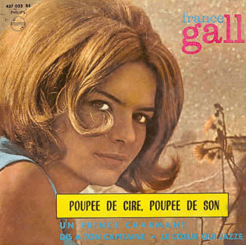1960s pop had been in full swing since the Beatles conquered America, sparking the so-called second “British Invasion” and eventually taking the entire world by storm. It led the other countries to develop their own version of the “British Invasion” pop sound. France was one of the countries that were caught up in the 1960s pop frenzy that swept the rest of the world. It’s called “Yé-yé,” which was derived from the English “Yeah, yeah!” popularized by the British beat music bands such as the Beatles and the Rolling Stones.
On the surface, someone would dismiss yé-yé as just a French imitation of the 1960s British and American pop. Another factor that makes yé-yé seem further dismissive is that it essentially consists of sticky sweet teenagers – mostly girls – singing French-language versions of British and American pop hits; or, a new teenage female singer hogging 15 minutes of fame per week.
But au contraire, there is something else about yé-yé that has a certain je ne sais quoi. The movement incorporates different and diverse stylistic elements. They include baroque, exotica, jazz, pop, and most especially, chanson – a term referring to any lyric-driven French song that initially gained popularity at music halls and cabarets. Plus, another factor that makes yé-yé quite distinctive is its frequent use of sexual innuendo, double entendre, and deadpan humor. And more so when such songs were performed by hapless teens like France Gall, who was too naïve to understand some of the songs she sang that had sexual innuendo in them or was actually a reference to herself, exploiting her innocence.
Speaking of France Gall, she was one of the first successful artists associated with the yé-yé movement. She was only sixteen when she won the Eurovision Song Contest (representing Luxembourg) for her entry “Poupée de cire, poupée de son,” written by Serge Gainsbourg. It was to be one of her most popular songs.
A good deal of yé-yé singers gained exposure on Salut les copains, a popular radio program in France that would showcase a “pop sweetheart” every week. Other artists, such as Françoise Hardy, Sylvie Vartan, and Jane Birkin were among the leading stars of this movement. Many records from the era still command a high price among collectors.
Unlike their European brethren (for the exception of the British, of course), the French were more willing to support their own singers and artists singing in their mother tongue. As a result, France became the biggest market for French-language pop songs at the time.
Let’s go back to one of the components of the yé-yé that makes it truly unique – the playfully risqué lyrical content. Just think of France Gall’s “Les Sucettes,” also written by Gainsbourg, which was superficially about a girl enjoying her aniseed lollipop, but was actually about oral sex. Gall insisted that she did not understand “Les Sucettes”’s double meaning at the time, even when the film clip for the song featured giant dancing phallic figures and women suggestively sucking lollipops.
When the yé-yé movement became popular in its own right, it began to spread across Western Europe. Italian singers such as Mina and Rita Pavone were among the first yé-yé stars in their country. Spain, despite its dominant Roman Catholic religion that seemed to be at odds with yé-yé’s off-color lyrical content, also shared the yé-yé spotlight. Singers such as Massiel and Karina enjoyed success as Spain’s yé-yé queens with a string of pop hits.
Although yé-yé proved to be a short-lived genre after its prime, there have been some yé-yé resurgences here and there in the following decades. It has also lent a considerable cultural impact on other countries. Japan, for example, was quite enamored with the yé-yé movement that the country adopted it as a basis for its homegrown music genres, most notably Shibuya-kei and Japanese idol music.
Other artists have carried on the yé-yé tradition and style, such as American singer April March (who sings in English and French) and Belgian singer and actress Helena Noguerra.
